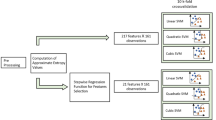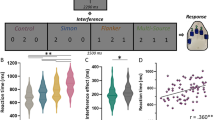Abstract
EEG power mapping in the frequency bands from Δ to γ2 was used to study the changes in the background cerebral activity during “successful” cognitive aging, with the cognitive ability preserved, in subjects engaged in complex occupational activities. The sample consisted of an older age group (OAG) of 32 subjects (14 men and 18 women with a mean age of 65.1 ± 1.18 years) and a younger age group (YAG) of 33 subjects (18 men and 15 women with a mean age of 22.1 ± 0.38 years). The mean power of the slow (Δ, θ, and α2) rhythms decrease with age, and that of the fast (β and γ) rhythms increase with age. The heterogeneity of the power parameters recorded at different sites was decreased in the OAG compared to the YAG. The centro-lateral power gradient was smoothed in the frequency bands from Δ- to β2-, and both the centro-lateral and fronto-parietal power gradients and interhemispheric differences, in the α- and β1 bands in the OAG. The results suggest that the observed age-related changes are prerequisites for the involvement of compensatory mechanisms, which may be related to both mobilization of larger resources ensuring cognitive activity and reorganization of cortical networks in the areas prone to age-related physiological changes.
Similar content being viewed by others
References
Verhaeghen, P. and Cerella, J., Everything We Know About Aging and Response Times: A Meta-Analytic Integration, in The Handbook of Cognitive Aging: Interdisciplinary Perspectives, Los Angeles: SAGE, 2008, p. 1.
Braver, T.S. and West, R., Working Memory, Executive Control, and Aging, in The Handbook of Aging and Cognition, New York: Psychology, 2008, p. 311.
Old, S.R. and Naveh-Benjamin, M., Differential Effects of Age on Item and Associative Measures of Memory: Ameta-Analysis, Psychol. Aging, 2008, vol. 23, no. 1, p. 104.
Ylikoski, R., Ylikoski, A., Keskivaara, P., et al., Heterogeneity of Cognitive Profiles in Aging: Successful Aging, Normal Aging, and Individuals at Risk for Cognitive Decline, Eur. J. Neurol., 1999, vol. 6, p. 645.
Finkel, D., Reynolds, C.A., McArdle, J.J., and Pedersen, N.L., The Longitudinal Relationship between Processing Speed and Cognitive Ability: Genetic and Environmental Influence, Behav. Genet., 2005, vol. 35, p. 535.
Kempermann, G., Gast, D., and Gage, F.H., Neuroplasticity in Old Age: Sustained Fivefold Induction of Hippocampal Neurogenesis by Long-Term Environmental Enrichment, Ann. Neurol., 2002, vol. 52, no. 2, p. 135.
Bennett, E.L., Diamond, M.C., Krech, D., and Rosenzweig, M.R., Chemical and Anatomical Plasticity of Brain, J. Neuropsychiatry Clin. Neurosci., 1996, vol. 8, no. 4, p. 459.
Riege, W.H., Environmental Influences on Brain and Behavior of Year-Old Rats, Dev. Psychobiol., 1971, vol. 4, no. 2, p. 157.
Klimesch, W., Doppelmayr, M., and Hanslmayr, S., Upper Alpha ERD and Absolute Power: Their Meaning for Memory Performance, Prog. Brain Res., 2006, vol. 159, p. 151.
Volf, N.V. and Tarasova, I.V., The Relationships between EEG θ and β Oscillations and the Level of Creativity, Fiziol. Chel., 2010, vol. 36, no. 2, p. 15 [Human Physiol. (Engl. Transl.), vol. 36, no. 2, p. 132].
Razoumnikova, O.M., Reflection of the Intelligence Structure in the Spatiotemporal Features of the Baseline EEG, Fiziol. Chel., 2003, vol. 29, no. 5, p. 115 [Human Physiol. (Engl. Transl.), vol. 29, no. 5, p. 619].
Celesia, G.G., EEG and Event-Related Potentials in Aging and Dementia, J. Clin. Neurophysiol., 1986, vol. 3, p. 99.
Ehlers, C.L. and Kupfer, D.J., Effects of Age on Delta and REM Sleep Parameters, EEG Clin. Neurophysiol., 1989, vol. 72, p. 118.
Klass, D.W. and Brenner, R.P., Electroencephalography of the Elderly, J. Clin. Neurophysiol., 1995, vol. 12, p. 116.
Obrist, W.D., The Electroencephalogram of Normal Aged Adults, EEG Clin. Neurophysiol., 1954, vol. 6, p. 235.
Obrist, W.D., Sokoloff, L., Lassen, N.A., et al., Relation of EEG to Cerebral Blood Flow and Metabolism in Old Age, EEG Clin. Neurophysiol., 1963, vol. 15, p. 610.
Woodruff, D.S. and Kramer, D.A., EEG Alpha Slowing, Refractory Period, and Reaction Time in Aging, Exp. Aging Res., 1979, vol. 5, p. 279.
Roubicek, I., The Electroencephalogram in the Middle-Aged and the Elderly, J. Am. Geriatr. Soc., 1977, vol. 25, p. 145.
Zenkov, L.R. and Ronkin, M.A., Funktsional’naya diagnostika nervnykh boleznei (Functional Diagnosis of Neurological Diseases), Moscow: Meditsina, 1991.
Duffy, F.H., Albert, M.S., McAnulty, G., and Gamey, A.J., Age-Related Differences in Brain Electrical Activity of Healthy Subjects, Ann. Neurol., 1984, vol. 16, p. 430.
Breslau, J., Starr, A., Sicotte, N., et al., Topographic EEG Changes with Normal Aging and SDAT, EEG Clin. Neurophysiol., 1989, vol. 72, p. 281.
Williamson, P.C., Merskey, H., Momson, S., et al., Quantitative Electroencephalographic Correlates of Cognitive Decline in Normal Elderly Subjects, Arch. Neurol., 1990, vol. 47, p. 1185.
Babiloni, C., Binetti, G., Cassarino, A., et al., Sources of Cortical Rhythms in Adults during Physiological Aging: a Multicentric EEG Study, Hum. Brain Mapp., 2006, vol. 27, no. 2, p. 162.
Cummins, T.D. and Finnigan, S., Theta Power Is Reduced in Healthy Cognitive Aging, Int. J. Psychophysiol., 2007, vol. 66, no. 1, p. 10.
Goh, J. and Park, D.C., Neuroplasticity and Cognitive Aging: The Scaffolding Theory of Aging and Cognition, Restor. Neurol. Neurosci., 2009, vol. 27, no. 5, p. 391.
Saito, N., Analytic Study on EEG Features of Aging with/without Psychiatric Disorders: Focussing at the Alterations in the EEGs of the Healthy, Depressive and Demented Elderlies, Seish Seish. Shinkeigaku Z., 1995, vol. 97, no. 10, p. 801.
Volf, N.V., Polovye razlichiya funktsional’noi organizatsii protsessov polusharnoi obrabotki rechevoi informatsii (Sex-Related Differences in the Functional Organization of Hemispheric Processing of Speech Information), Rostov-on-Don: TsVVR, 2000.
Förstl, H., Besthorn, C., Sattel, H., et al., Volumetric Brain Changes and Quantitative EEG in Normal Aging and Alzheimer’s Dementia, Nervenarzt, 1996, vol. 67, no. 1, p. 53.
Hartikainen, P., Soininen, H., Partanen, J., et al., Aging and Spectral Analysis of EEG in Normal Subjects: a Link to Memory and CSF AChE, Acta Neurol. Scand., 1992, vol. 86, no. 2, p. 148.
Basar, E., Basar, E.C., Karakas, S.M., and Scurmann, M., Brain Oscillation in Perception and Memory, Int. J. Psyhophysiol., 2000, vol. 35, nos. 2–3, p. 95.
Klimesch, W., EEG Alpha and Theta Oscillations Reflect Cognitive and Memory Performance: a Review and Analysis, Brain Res. Brain Res. Rev., 1999, vol. 29, nos. 2–3, p. 169.
Baar, E., Başar-Eroglu, C., Karakaş, S., and Schürmann, M., Gamma, Alpha, Delta, and Theta Oscillations Govern Cognitive Processes, Int. J. Psychophysiol., 2001, vol. 39, nos. 2-3, p. 241.
Aftanas, L.I., Varlamov, A.A., Reva, N.V., and Pavlov, S.V., Effect of Alexithymia on the Event-Related Theta-Synchronization of Human EEG during Reception of Emotional Visual Stimuli, Ross Fiziol. Zh. im. I.M. Sechenova, 2003, vol. 89, no. 8, p. 926.
Bresnahan, S.M., Anderson, J.W., and Barry, R.J., Age-Related Changes in Quantitative EEG in Attention-Deficit/Hyperactivity Disorder, Biol. Psychiatry, 1999, vol. 46, no. 12, p. 1690.
Fernandez, A., Arrazola, J., Maestu, F., et al., Correlations of Hippocampal Atrophy and Focal Low-Frequency Magnetic Activity in Alzheimer Disease: Volumetric MR Imaging: Magnetoencephalographic Study, AJNR Am. J. Neuroradiol., 2003, vol. 24, p. 481.
Volf, N.V., Tarasova, I., and Razumnikova, O.M., Motivation in Creative Task: Impact on Individual Differences in Task-Related Alpha Oscillations, in Advances in Biomedical Research: Proceedings of the International Conference on Medical Physiology, University of Cambridge, 2010, p. 215.
Man’kovskii, N.B., Mints, A.Ya., Kuznetsova, S.M., and Belonog, R.P., Dolgozhiteli. Neirofiziologicheskie aspekty (Long-Livers: A Neurophysiological Perspective), Leningrad: Nauka, 1985.
Miyasaka, M., Nakano, T., Ohmori, K., et al., The Mental Deterioration in the Aged and the Computerized EEG Analysis, Folia Psychiatr. Neurol. Jap., 1978, vol. 32, p. 95.
Marciani, M.G., Maschio, M., Spanedda, F., et al., Quantitative EEG Evaluation in Normal Elderly Subjects during Mental Processes: Age-Related Changes, J. Neurosci., 1994, vol. 76, p. 131.
Holschneider, D.P. and Leuchter, A.F., Beta Activity in Aging and Dementia, Brain Topogr., 1995, vol. 8, no. 2, p. 169.
Thompson, L.W. and Wilson, S., Electrocortical Reactivity and Learning in the Elderly, J. Gerontol., 1966, vol. 21, p. 45.
Liddell, B.J., Paul, R.H., Arns, M., et al., Rates of Decline Distinguish Alzheimer’s Disease and Mild Cognitive Impairment Relative to Normal Aging: Integrating Cognition and Brain Function, J. Integr. Neurosci., 2007, vol. 6, no. 1, p. 141.
Nikolaev, A.R., Anokhin, A.P., Ivanitskii, G.A., et al., Spectral Rearrangement of EEG and the Organization of Cortical Connections during Image and Verbal Thinking, Zh. Vyssh. Nervn. Deyat. im. I.P. Pavlova, 1996, vol. 46, p. 831.
Pulvermuller, F., Birbaumer, N., Lutzenberger, W., and Mohr, B., High-Frequency Brain Activity: Its Possible Role in Attention, Perception and Language Processing, Prog. Neurobiol., 1997, vol. 52, p. 427.
Tallon-Baudry, C., The Roles of Gamma-Band Oscillatory Synchrony in Human Visual Cognition, Front Biosci., 2009, vol. 14, p. 321.
Hanslmayr, S., Aslan, A., Staudigl, T., et al., Prestimulus Oscillations Predict Visual Perception Performance between and within Subjects, NeuroImage, 2007, vol. 37, p. 1465.
Cacace, A.T. and McFarland, D.J., Spectral Dynamics of Electroencephalographic Activity during Auditory Information Processing, Hear Res., 2003, vol. 176, nos. 1–2, p. 25.
Dustman, R.E., Emmerson, R.Y., and Shearer, D.E., Life Span Changes in Electrophysiological Measures of Inhibition, Brain Cogn., 1996, vol. 30, no. 1, p. 109.
Bragina, N.N. and Dobrokhotova, T.A., Funktsional’nye asimmetrii cheloveka (Human Functional Asymmetries), Moscow: Meditsina, 1988.
Fokin, V.F. and Ponomareva, N.V., Dynamic Characteristics of Functional Interhemispheric Asymmetry, in Funktsional’naya mezhpolusharnaya asimmetriya (Functional Interhemispheric Asymmetry), Moscow: Nauchnyi Mir, 2004, p. 349.
Dolcos, F., Rice, H.J., and Cabeza, R., Hemispheric Asymmetry and Aging: Right Hemisphere Decline or Asymmetry Reduction, Neurosci. Biobehav. Rev., 2002, vol. 26, no. 7, p. 819.
Cabeza, R., Cognitive Neuroscience of Aging: Contributions of Functional Neuroimaging, Scand. J. Psychol., 2001, vol. 42, no. 3, p. 277.
Cabeza, R., Anderson, N.D., Locantore, J.K., et al., Aging Gracefully: Compensatory Brain Activity in High-Performing Older Adults, NeuroImage, 2002, vol. 17, no. 3, p. 1394.
Author information
Authors and Affiliations
Additional information
Original Russian Text © N.V. Volf, A.A. Gluhih, 2011, published in Fiziologiya Cheloveka, 2011, Vol. 37, No. 5, pp. 51–60.
Rights and permissions
About this article
Cite this article
Volf, N.V., Gluhih, A.A. Background cerebral electrical activity in healthy mental aging. Hum Physiol 37, 559–567 (2011). https://doi.org/10.1134/S0362119711040207
Received:
Published:
Issue Date:
DOI: https://doi.org/10.1134/S0362119711040207




